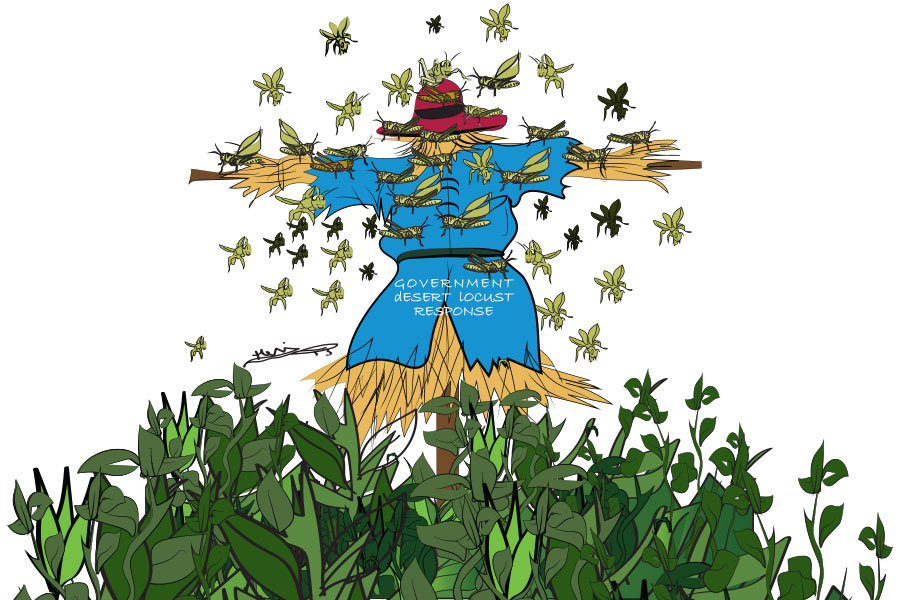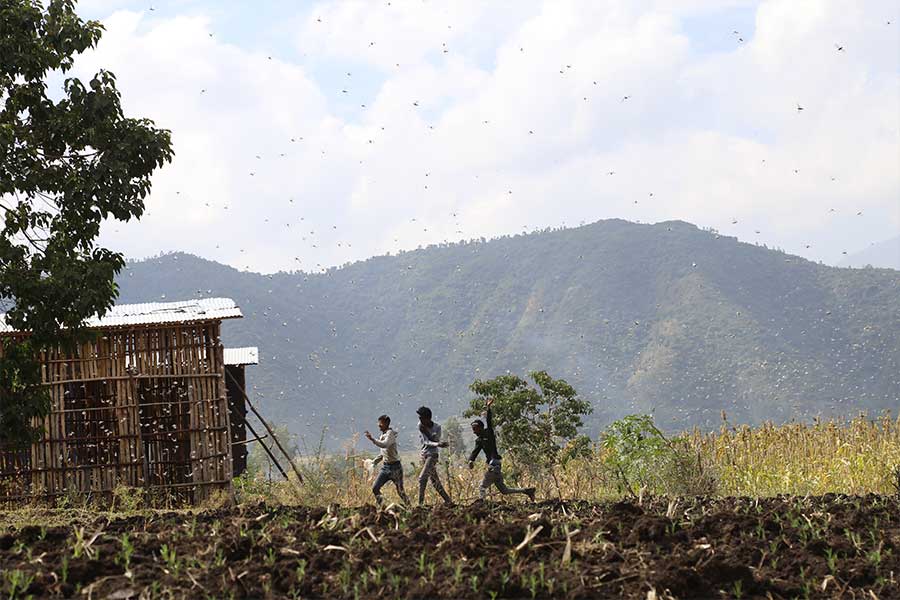
Editorial | Oct 16,2020
Authorities warn that yet another wave of desert locust infestation could be heading to Ethiopia, as signs of an impending invasion are evident across several regions.
Heavy rainfall, greater plant coverage, conducive winds and moisturised soil have created favourable conditions for the desert pests in five regional states, according to experts. Locust swarms are expected to make landfall between now and the end of next month though it is difficult to say how severe the invasion will be.
Particularly vulnerable are areas in Afar Regional State, North Shoa, North Gonder, parts of Oromia Regional State, Harerge and Sitti Zone of Somali Regional State, according to the National Meteorology Agency.
The season is very suitable for the locusts to spread; the rainy season is already here now in some parts of the country, said Yimer Assefa, agro-meteorology coordinator at the Agency.
"The current heavy rain by itself may not be convenient for the locusts, but the moisture it creates and the wind that comes with it would help the locusts spread," says Yimer. "The Meher season crop-growing areas are at serious risk now."
There are reports of locusts already in neighbouring Somalia and Djibouti, and a change in wind direction would carry the swarms to Ethiopia, potentially devastating farmlands and agricultural output.
The locust invasions of 2020 were of a scale that had not been seen in over a quarter of a century. The insects covered over 200,000ht of cropland and destroyed an estimated 2.5pc of the country's total agricultural output, putting millions at risk of food insecurity.
Although the locust invasions are more or less a yearly occurrence, they were vastly smaller in scale before 2019 and consisted of a domestic species of locust that was generally small in size and not much of a threat. However, two years ago, signs of the continental desert locust appeared, with a more serious threat emerging from across the Red Sea in Yemen.
This time around, even though the size of the swarms is small, there are still signs that if efforts are not exerted to contain the threat, the damage can be more devastating than last year, according to Belayneh Nigussie, plant protection director at the Ministry of Agriculture.
Belayneh cites that the desert locusts in Djibouti and Somalia are the biggest threats to Ethiopia currently as the two countries are not fully dependent on agriculture and have little in the way of containment efforts. Some of these locusts have already lain eggs in the country. Clusters of eggs in Somali Regional State were discovered a few weeks ago but were destroyed right away, according to Belayneh.
"Due to the nature of the desert locust, it actually takes a minimum of two or more years to completely eradicate them, and even that is when working at full capacity," he says, while explaining why the same threat is facing the country again.
A few weeks ago, the city of Kombolcha, in northeastern Amhara Regional State, saw a desert locust invasion that forced the suspension of flights to its Airport for two days.
“We couldn't use chemical sprays for fear of contaminating the population,” said Belayneh.
The same group of desert locusts is still considered to be circulating in the Amhara and the Afar regional states, potentially even laying eggs. So far, no crops have been affected, according to the Ministry of Agriculture.
The Ministry is not expecting major losses this year, attributing its bullish prediction to the preparations it is undergoing. Its officials have been taking measures in collaboration with the Food and Agriculture Organisation of the United Nations (FAO).
Equipment-wise, the Ministry currently has seven aircraft and around 200 vehicles prepared for survey and prevention works, of which two aircraft were leased and five aircraft acquired with the support of FAO, along with its donation of 40 vehicles.
“FAO supports countries year to year through its different programmes,” says Bayeh Mulatu (PhD), entomologist and integrated pest management expert at FAO. “Logistics, communications, survey, technical and human support are what we are mainly providing.”
Bayeh refrained from providing full-scale analytical survey reports on the damage the desert locust invasion caused last year, saying that the overall environmental assessments are currently underway.
He cited that heavy rainfall in Middle Eastern countries such as Yemen, Saudi Arabia and Oman, was the root cause of the invasions last year, which left 3.3 million people in the Horn of Africa in need of food assistance. Furthermore, even though there currently seems to be no sign of desert locusts migrating from Yemen, Bayeh disclosed that there have been some heavy rains in the country over the last few weeks, potentially heralding another wave of huge swarms.
Concerned about the timing, Messay Mulugeta (PhD), a food security expert, says that the government should take every possible precaution over the next two months as crops such as corn would be growing, especially in the lowlands.
“It appears that the government took a lesson from the previous year and is preparing to control [the situation], but it should be a very cautious approach given the country's vast area and its massive agricultural land,” warns Messay.
He stresses that the concerned bodies should work to raise awareness among farmers.
PUBLISHED ON
Jul 24,2021 [ VOL
22 , NO
1108]

Editorial | Oct 16,2020

Verbatim | Mar 02,2019

Fortune News | Jan 30,2021

Viewpoints | Mar 25,2023

Radar | Feb 22,2020

Fortune News | Feb 04,2023

Featured | Sep 14,2019

Viewpoints | Oct 23,2021

Editorial | Jul 22,2023

View From Arada | Dec 26,2020

Dec 22 , 2024 . By TIZITA SHEWAFERAW
Charged with transforming colossal state-owned enterprises into modern and competitiv...

Aug 18 , 2024 . By AKSAH ITALO
Although predictable Yonas Zerihun's job in the ride-hailing service is not immune to...

Jul 28 , 2024 . By TIZITA SHEWAFERAW
Unhabitual, perhaps too many, Samuel Gebreyohannes, 38, used to occasionally enjoy a couple of beers at breakfast. However, he recently swit...

Jul 13 , 2024 . By AKSAH ITALO
Investors who rely on tractors, trucks, and field vehicles for commuting, transporting commodities, and f...

Oct 18 , 2025
The political establishment, notably the ruling party and its top brass, has become p...

Oct 11 , 2025
Ladislas Farago, a roving Associated Press (AP) correspondent, arrived in Ethiopia in...

Oct 4 , 2025
Eyob Tekalegn (PhD) had been in the Governor's chair for only weeks when, on Septembe...

Sep 27 , 2025
Four years into an experiment with “shock therapy” in education, the national moo...